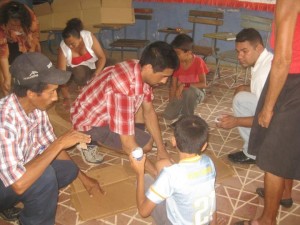Adaptive Equipment Makes a Difference
/“1, 2, 3, Freeze. Please stop measuring, cutting, and gluing!” The eyes of four closely huddled groups willfully peeled their attention away from their projects to look my direction. They were engrossed in their last cardboard construction challenge of the intro workshop: to make a cardboard box strong enough to stand on. “Okay," I said, "I want you to take one minute to reflect about the past 15 minutes with your group. Together, name one good theme and one bad theme that arose in your experience of working together as a team. And think of something to do differently to address the bad theme.”
The approach to this taller - or workshop - differed greatly from the first. Rosa and I realized that this was the first time that all seven of the different communities would be together. Many participants did not have much experience working creatively in groups – and some were perhaps too used to being the outspoken leader of a group! I also learned from my first taller that touching each other with attention was so new to some of the students that we would have to do much of it to overcome the initial shock, in order to begin engaging in learning about the body.
And so when the director of the Ministry of Health came to observe what we were doing that day, she arrived to see five different groups clustered together attempting to figure out how to find the exact beginning and end of the bicep muscle. When a group was ready, I randomly chose two members and brought them outside to demonstrate how to find the muscle on my arm. If they were unable to locate it or say how they found it, I gave them a tutorial and sent them back to the group to share their training with the others. (I'll share more about the director in the next blog.)
As this taller drew to a close, I could feel a wonderful sense of accomplishment among the students. All the groups had successfully worked together to construct boxes that I - at just under 150 pounds - could stand on. People who had not spoken before now jumped in with ideas and ways to evaluate and treat the final case studies I role-played with them, and those who had previously led listened and welcomed the teamwork. It seemed to me that we had achieved a level of understanding about what a muscle was and that they could help alleviate pain in it, stretch it, strengthen it and make a difference in a community member’s life.


